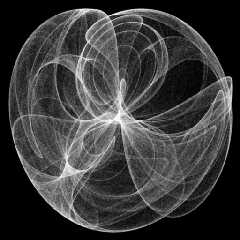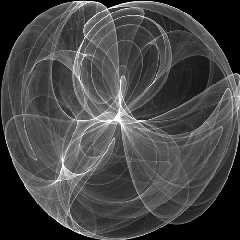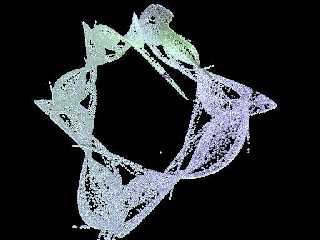 |
 |
|
 |
|
 |
|  |
|  |
|
 |
|
 |
|  |
|  |
|
 |
The code for this image is by Manuel Kasten, who posted it in
povray.general. The scene contains 2.000.000 little white spheres. He
couldn't render it himself though, because of heavy swapping.
Now, I don't have enough memory either, but what I did was to reduce the
memory usage by rendering the image over 20 passes each with 100.000
spheres, each time using the previous frame as a background image_map
for the current frame. The result looks nice. It's attached. Well, I
blurred it in Paint Shop Pro before posting in order to reduce
graininess and jpeg-artifacts. The original really isn't blurred at all
despite the multiple times applied antialiasing that is a side effect
from the multiple pass technique I used.
Rune
--
3D images and anims, include files, tutorials and more:
rune|vision: http://runevision.com **updated Mar 9**
POV-Ray Ring: http://webring.povray.co.uk
Post a reply to this message
Attachments:
Download 'attractors.jpg' (55 KB)
Preview of image 'attractors.jpg'

|
 |
|  |
|  |
|
 |
|
 |
|  |
|  |
|
 |
"Rune" <run### [at] runevision com> wrote in message
news:4054f58c@news.povray.org...
> The code for this image is by Manuel Kasten, who posted it in
> povray.general. The scene contains 2.000.000 little white spheres. He
> couldn't render it himself though, because of heavy swapping.
>
> Now, I don't have enough memory either, but what I did was to reduce the
> memory usage by rendering the image over 20 passes each with 100.000
> spheres, each time using the previous frame as a background image_map
> for the current frame. The result looks nice. It's attached. Well, I
> blurred it in Paint Shop Pro before posting in order to reduce
> graininess and jpeg-artifacts. The original really isn't blurred at all
> despite the multiple times applied antialiasing that is a side effect
> from the multiple pass technique I used.
AWESOME technique!!!
--
- Respectfully,
Dan
http://<broken link> com> wrote in message
news:4054f58c@news.povray.org...
> The code for this image is by Manuel Kasten, who posted it in
> povray.general. The scene contains 2.000.000 little white spheres. He
> couldn't render it himself though, because of heavy swapping.
>
> Now, I don't have enough memory either, but what I did was to reduce the
> memory usage by rendering the image over 20 passes each with 100.000
> spheres, each time using the previous frame as a background image_map
> for the current frame. The result looks nice. It's attached. Well, I
> blurred it in Paint Shop Pro before posting in order to reduce
> graininess and jpeg-artifacts. The original really isn't blurred at all
> despite the multiple times applied antialiasing that is a side effect
> from the multiple pass technique I used.
AWESOME technique!!!
--
- Respectfully,
Dan
http://<broken link>
Post a reply to this message
|
 |
|  |
|  |
|
 |
|
 |
|  |
|  |
|
 |
> The original really isn't blurred at all
> despite the multiple times applied antialiasing that is a side effect
> from the multiple pass technique I used.
If you used no interpolation (the default) and aligned the background image
properly, then the AA'ing shouldn't have caused any blurring.
- Slime
[ http://www.slimeland.com/ ]
Post a reply to this message
|
 |
|  |
|  |
|
 |
|
 |
|  |
|  |
|
 |
Slime wrote:
> If you used no interpolation (the default) and aligned
> the background image properly, then the AA'ing shouldn't
> have caused any blurring.
Now that I think a bit more about it, I think you're right. And it does
indeed seem like there was no blurring at all. (And yes, I did use no
interpolation and aligned the background image properly.)
Rune
--
3D images and anims, include files, tutorials and more:
rune|vision: http://runevision.com **updated Mar 9**
POV-Ray Ring: http://webring.povray.co.uk
Post a reply to this message
|
 |
|  |
|  |
|
 |
From: Timothy Cook
Subject: Re: Strange Attractors by Manuel Kasten
Date: 15 Mar 2004 01:03:17
Message: <40554725@news.povray.org>
|
|
 |
|  |
|  |
|
 |
Dan P wrote:
> AWESOME technique!!!
Shouldn't that be 'AWESUM ROLEX'? ;)
--
Tim Cook
http://home.bellsouth.net/p/PWP-empyrean
-----BEGIN GEEK CODE BLOCK-----
Version: 3.12
GFA dpu- s: a?-- C++(++++) U P? L E--- W++(+++)>$
N++ o? K- w(+) O? M-(--) V? PS+(+++) PE(--) Y(--)
PGP-(--) t* 5++>+++++ X+ R* tv+ b++(+++) DI
D++(---) G(++) e*>++ h+ !r--- !y--
------END GEEK CODE BLOCK------
Post a reply to this message
|
 |
|  |
|  |
|
 |
From: Manuel Kasten
Subject: Re: Strange Attractors by Manuel Kasten
Date: 15 Mar 2004 01:42:29
Message: <40555055@news.povray.org>
|
|
 |
|  |
|  |
|
 |
> The code for this image is by Manuel Kasten, who posted it in
> povray.general. The scene contains 2.000.000 little white spheres. He
> couldn't render it himself though, because of heavy swapping.
The code is based on Paul Bourkes scc3 entry.
> Now, I don't have enough memory either, but what I did was to reduce the
> memory usage by rendering the image over 20 passes each with 100.000
> spheres, each time using the previous frame as a background image_map
> for the current frame. The result looks nice. It's attached. Well, I
> blurred it in Paint Shop Pro before posting in order to reduce
> graininess and jpeg-artifacts. The original really isn't blurred at all
> despite the multiple times applied antialiasing that is a side effect
> from the multiple pass technique I used.
Thank you! That's a great idea. Because I couldn't get around that problem
for myself, but wanted to play with attractors more, I wrote a Java program
(so the following picture is _NOT POVRAY CREATED_). It consits of merely
50 mio. points and was created in less than 2 minutes with a memory usage of
approx. 4 MB.
again: this is not povray generated, but related to the topic...
Post a reply to this message
Attachments:
Download 'attractor.jpg' (88 KB)
Preview of image 'attractor.jpg'

|
 |
|  |
|  |
|
 |
From: Florian Brucker
Subject: Re: Strange Attractors by Manuel Kasten
Date: 15 Mar 2004 01:58:11
Message: <40555403@news.povray.org>
|
|
 |
|  |
|  |
|
 |
> I wrote a Java program
> (so the following picture is _NOT POVRAY CREATED_). It consits of merely
> 50 mio. points and was created in less than 2 minutes with a memory usage of
> approx. 4 MB.
Cool! Looks much smoother than the POV one. No create some colorful
gradients within the attractor, add a "create random attractor"-button
and there goes the new wallpaper-machine :)
Do I understand it correctly that the attractor is a surface (or could
be represented as one)? It looks like it, so you could try to build a
(smooth) mesh from it. Then you could also do fancy stuff like nice
finishes etc. Of course you'd need POV again to do so.
Florian
Post a reply to this message
|
 |
|  |
|  |
|
 |
From: Manuel Kasten
Subject: Re: Strange Attractors by Manuel Kasten
Date: 15 Mar 2004 07:20:43
Message: <40559f9b@news.povray.org>
|
|
 |
|  |
|  |
|
 |
> Cool! Looks much smoother than the POV one. No create some colorful
> gradients within the attractor, add a "create random attractor"-button
> and there goes the new wallpaper-machine :)
Hmm, I don't have any idea how to colour them.
Plus I think they look much more artistic in 2 colors.
(I have some black attractors on light blue background as wallpaper)
> Do I understand it correctly that the attractor is a surface (or could
> be represented as one)? It looks like it, so you could try to build a
> (smooth) mesh from it. Then you could also do fancy stuff like nice
> finishes etc. Of course you'd need POV again to do so.
No, it's not a surface. It's a bunch of points on a 2D-coordinate system.
They look 3D, but they aren't.
Manuel Kasten
Post a reply to this message
|
 |
|  |
|  |
|
 |
From: Edward Coffey
Subject: Re: Strange Attractors by Manuel Kasten
Date: 15 Mar 2004 08:13:05
Message: <4055abe1@news.povray.org>
|
|
 |
|  |
|  |
|
 |
>>Do I understand it correctly that the attractor is a surface (or could
>>be represented as one)? It looks like it, so you could try to build a
>>(smooth) mesh from it. Then you could also do fancy stuff like nice
>>finishes etc. Of course you'd need POV again to do so.
>
>
> No, it's not a surface. It's a bunch of points on a 2D-coordinate system.
> They look 3D, but they aren't.
Which is not to say that you can't have 3D attractors. I wrote a quick
and dirty hack to search for sets of coefficients for a 3D quadratic
that produce nice attractors a while ago, I've been meaning to work on
it, perhaps I'll clean it up and post it here if anyone's interested.
The trouble with rendering it as a solid object is that you have no more
information than the location of each point - other than simple
proximity there is no way of knowing whether two points should be
connected forming part of a surface, or whether there is a gap between
them that should not be filled. In the end you either just plot so many
points that it looks like a single surface, or use a guessing algorithm
designed to form a surface from a collection of points.
The sample attaced is rendered by plotting each of the 65536 points as a
sphere. It looks a little flat, but you can see where a bit of it sticks
in front of the rest at around 8 o'clock, and a bit of twisting from
around 11 o'clock to 2 o'clock.
Post a reply to this message
Attachments:
Download 'attractor3d.jpg' (25 KB)
Preview of image 'attractor3d.jpg'

|
 |
|  |
|  |
|
 |
From: Zeger Knaepen
Subject: Re: Strange Attractors by Manuel Kasten
Date: 15 Mar 2004 10:17:02
Message: <4055c8ee@news.povray.org>
|
|
 |
|  |
|  |
|
 |
"Timothy Cook" <z99### [at] bellsouth net> schreef in bericht
news:40554725@news.povray.org...
> Dan P wrote:
> > AWESOME technique!!!
>
> Shouldn't that be 'AWESUM ROLEX'? ;)
IIRC it was "AWSOME ROLEX" :)
btw, Rune, nice image as always, but I believe in this case raytracing isn't
the way to go. Using scanline, you don't have to store all the points in
memory, only the one you're currently drawing, so it wouldn't be any problem
to draw millions or billions of points :)
(Unless there's something about this strange attractors that I don't know...
maybe you need every previous point to compute the next? :-/ :-))
cu!
--
ZK AKA Gaeriel
http://www.povplace.be.tf
"If we ain't outta here in ten minutes, we won't need no rocket to fly
through space." net> schreef in bericht
news:40554725@news.povray.org...
> Dan P wrote:
> > AWESOME technique!!!
>
> Shouldn't that be 'AWESUM ROLEX'? ;)
IIRC it was "AWSOME ROLEX" :)
btw, Rune, nice image as always, but I believe in this case raytracing isn't
the way to go. Using scanline, you don't have to store all the points in
memory, only the one you're currently drawing, so it wouldn't be any problem
to draw millions or billions of points :)
(Unless there's something about this strange attractors that I don't know...
maybe you need every previous point to compute the next? :-/ :-))
cu!
--
ZK AKA Gaeriel
http://www.povplace.be.tf
"If we ain't outta here in ten minutes, we won't need no rocket to fly
through space."
Post a reply to this message
|
 |
|  |
|  |
|
 |
|
 |
|  |




![]()